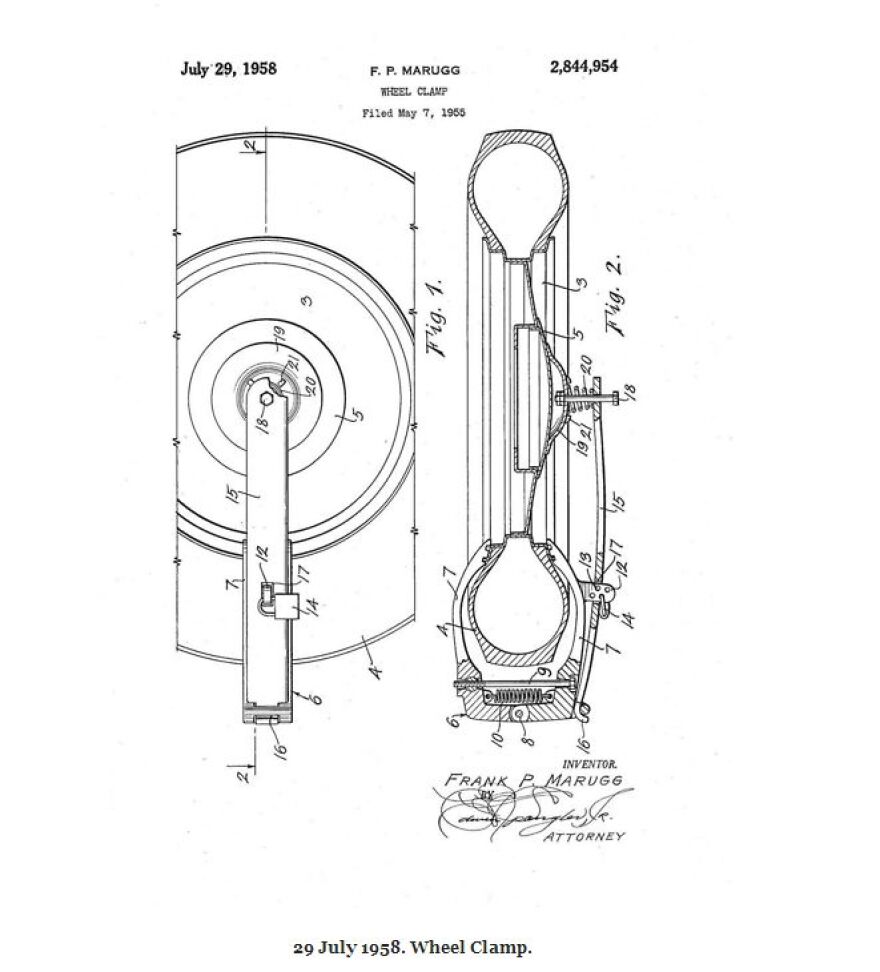It’s hard to think of any device in modern history that can provoke more feelings of intense rage, grief and sheer desperation than the wheel clamp, wheel boot, parking boot, or auto immobilizer.
All these are names for what's commonly known as the Denver Boot - because it was invented right here in Colorado.
For those among us with a sterling record who don’t know how it works, the boot is clamped onto a parked vehicle’s wheel – usually when someone has a number of unpaid parking violations – so the offender is unable to drive away without first paying the tickets.
First time I've seen a wheel clamp in #NYC. https://t.co/HsGBEgCOXv
— Peter Burka✊🏿 (@pburka) April 30, 2014
When people encounter the dreaded boot clamped onto their own car, it’s not uncommon for them to quickly cycle through some of the six stages of grief: Shock, denial, anger… and possibly, bargaining with the parking officer.

You might think a device this nefarious had to have been created by an evil scientist in a cold, sterile lab somewhere. But it’s actually the brainchild of a gifted Colorado musician – who also happened to be an inventor.
The story begins with a Denver man named Frank P. Marugg, according to Liz Wolfson, CFO for Clancy Systems International. The Denver-based company manufactures and sells the Denver Boot as a small part of its worldwide parking systems business.
“Marugg was a pattern maker, a shop teacher, a violinist with the then-Denver symphony… he even made his own violin,” Wolfson says. He also happened to be friends with a number of city politicians and police officers, whom he enjoyed chatting with frequently.
“Sitting around coffee one day, this policeman said ‘Oh my God, we have all these people with outstanding parking tickets. I wish there was something we could do to lock up their car so they couldn’t drive off and we could collect the money.’”
Turns out he was talking to the right person to make that happen. Marugg went home and focused his creativity and penchant for using his hands on the problem. Thus the Denver Boot was born.

The invention was a hit – if not with drivers, then certainly with city officials who had been losing tens of thousands of dollars annually in uncollected fines. Denver police began booting cars in the early 1950s, and a patent was issued for the device in 1958.
Because most cars of that era had similar wheels, the boot was pretty much a one-size-fits-all solution for parking scofflaws. Decades later, not much has changed in the way the boot functions, although its structure has changed to accommodate the huge variety of tires on modern vehicles.
Frank’s daughter, Grace Berg, continued operating the business after his death in 1973, although she wasn’t able to devote much time to promoting it. In 1986, Clancy Systems got in touch with her about marketing the boot, and acquired the company a few years later.
“Grace was trying to keep it alive,” Wolfson says. “She was so proud of her father… and she was thrilled to think that it would have an ongoing life.”
More Than A Strong-arm Fine Collector
The Denver boot certainly has enjoyed a longevity that other mechanical devices haven’t, in part because people have found it useful for securing trailers and other personal property.
“It’s not a security device, it was never destined to be a security device,” Wolfson says, “but a lot of people like to put it on a vehicle – say a classic car, boat trailer, a construction trailer – just as a little extra security so someone can’t just hook it up and drive off with it.”
Anyone can purchase a boot for their own use. Wolfson says many clients are private entities like condo associations or business owners who want to have some extra muscle behind parking enforcement. But regulations require that companies that use the boot follow some basic regulations and courtesies.
“One of the caveats is that it’s not an extortion device,” Wolfson says. “If they put it on a vehicle, they charge maybe $25 as a fine to remove it…. It should never be, you know, ‘Now we’ll charge you $500 to take it off your car.’”
A Timeless Tool In The Modern Age
Today there are much more high-tech measures to catch people with unpaid parking tickets, including registration holds from the Department of Motor Vehicles. But Wolfson says the Denver boot still does a brisk business. She doesn’t see the market for it going away anytime soon.
“I think there will always be a need,” she says. “Everything we do is so high tech. It’s kind of nice to take a step back to the mechanical world, and to know that in our life, something mechanical still has a purpose, still has a future. I kind of like that idea.”
So, a word to the wise: Whatever awesome means of travel we’re using in the future – hovercraft, pneumatic tubes, jet packs or sky train – there may also be a model of the Denver boot that will be able to clamp it.
"That's one small step... Oh no..." Changing History by Wheel Clamp http://t.co/szGzDbWG3C pic.twitter.com/T2NJwhspiA
— Marcel Broersma (@MJBroersma) April 13, 2014
Explore the map and help us find more of the lost, forgotten or the little-known in the Centennial State. Have an idea? Send us a tip for Hidden Colorado.







